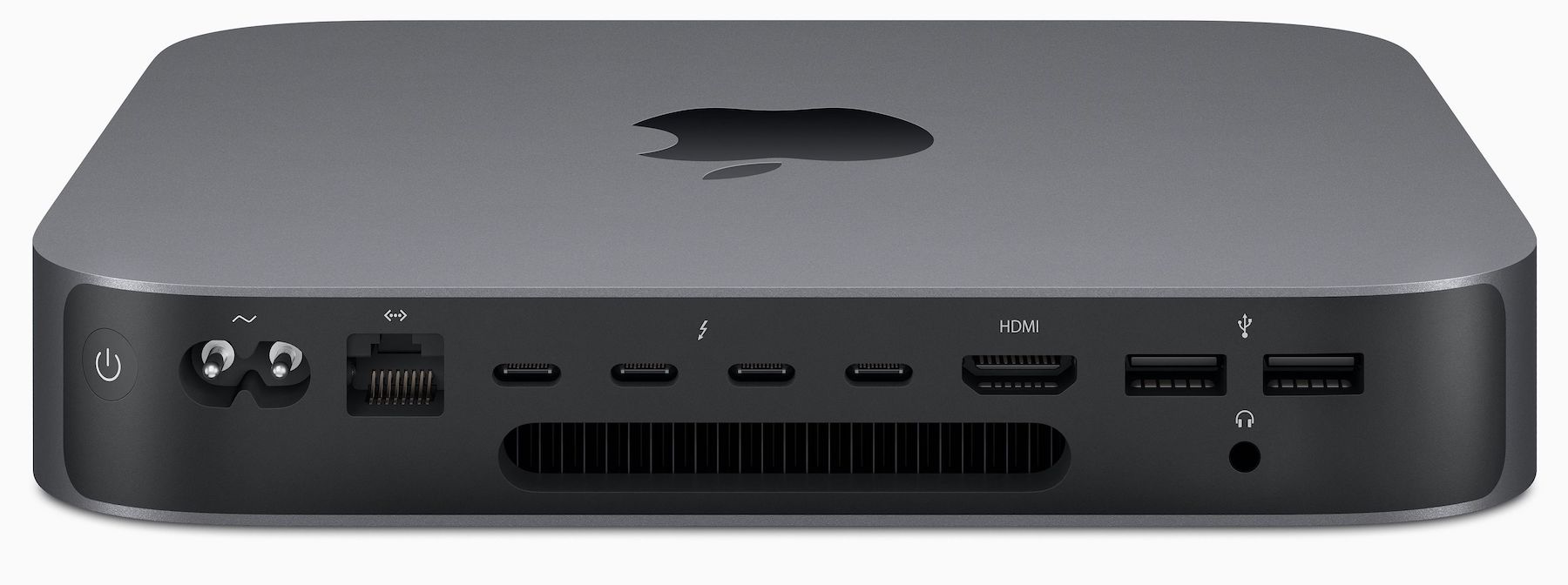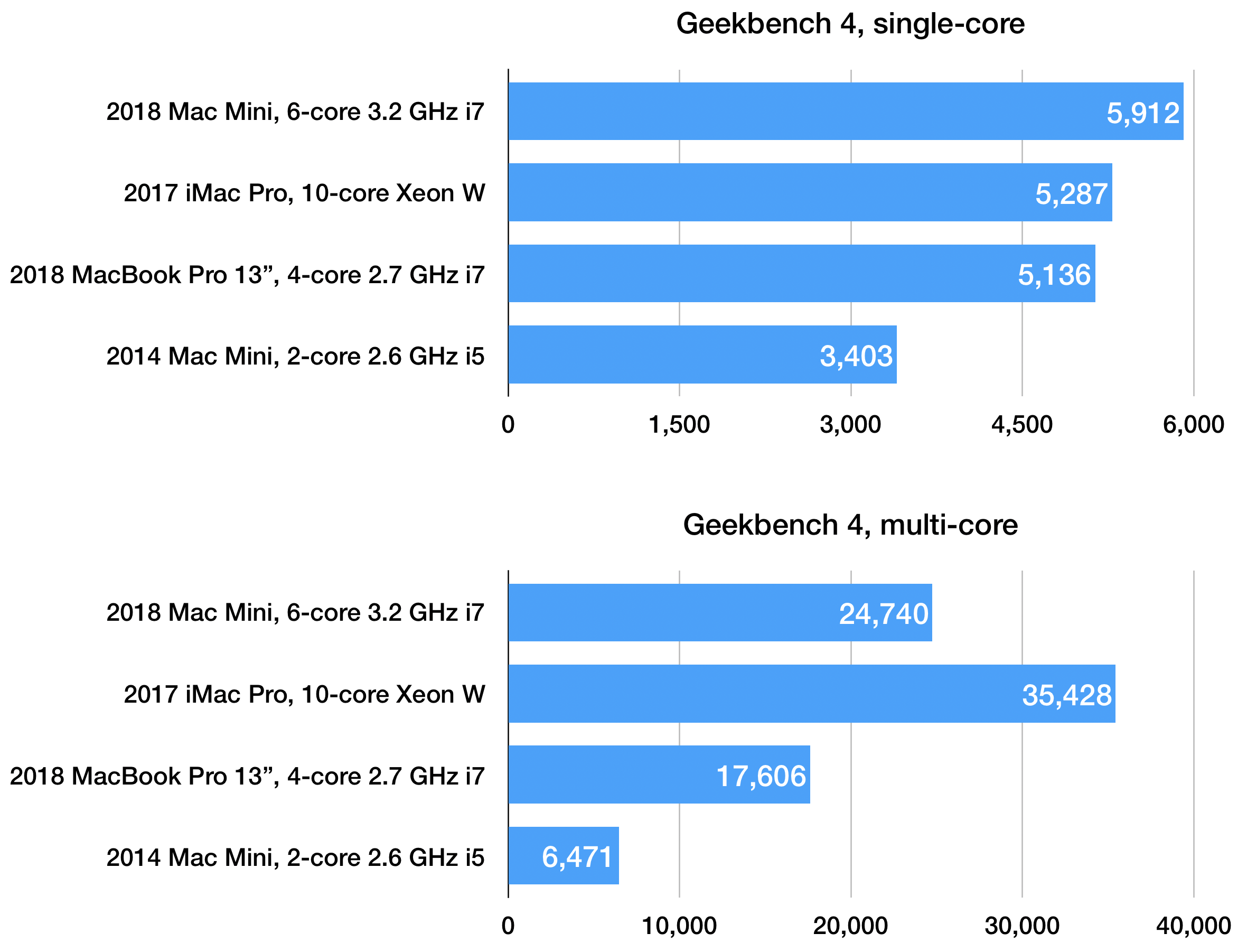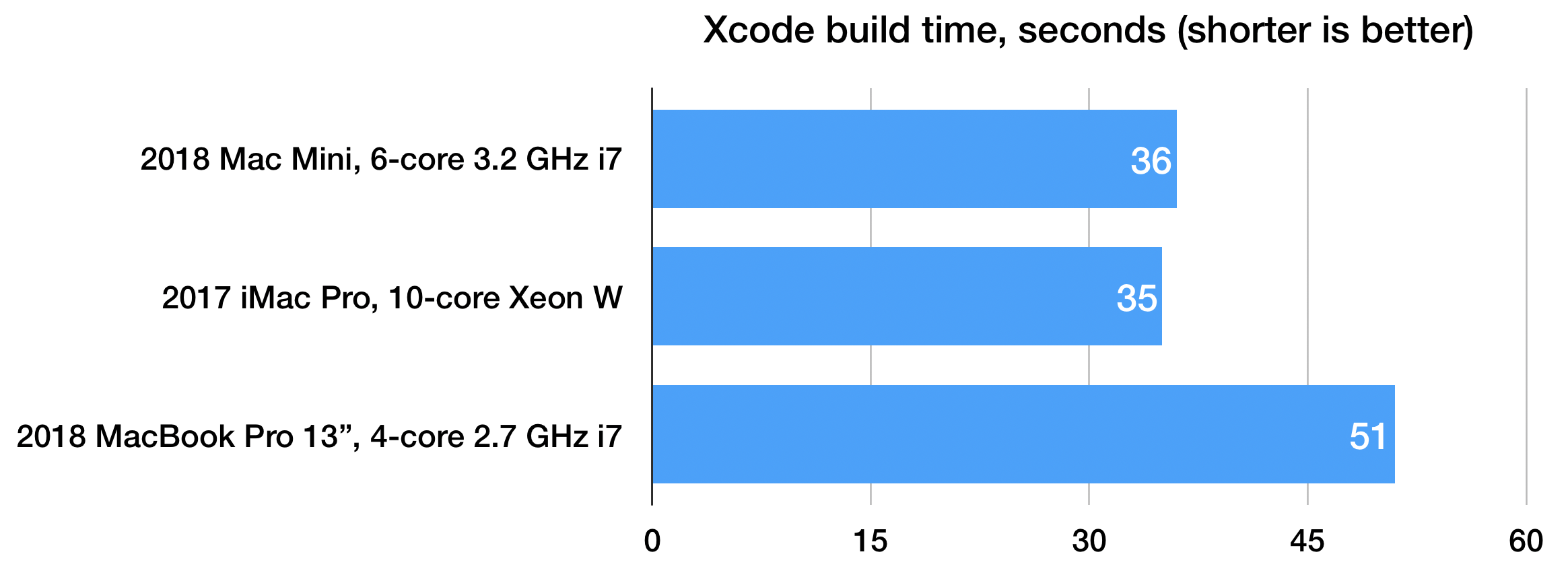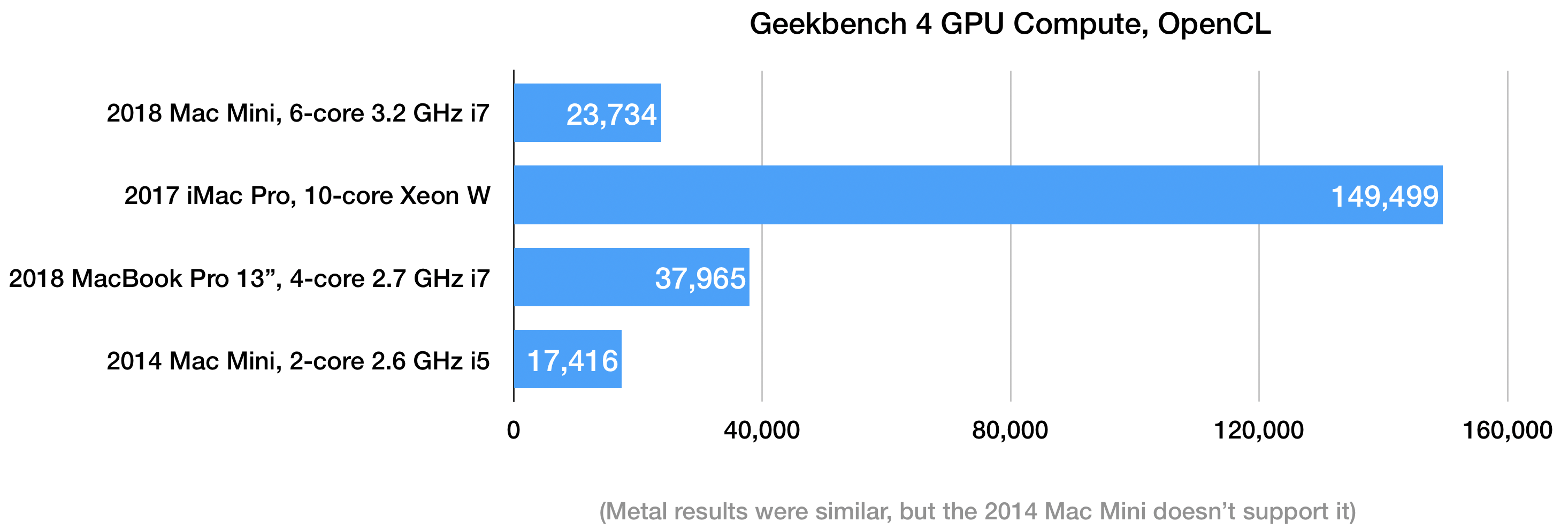The 2018 Mac Mini
I hardly ever think about my Mac Mini, but it serves a vital role for my family as our home-theater mixer, Plex server, ScanSnap server, Apple Photos backup, and Backblaze host for our NAS.1 Almost every port on the back is in use, and it runs 24/7, reliably, in total silence.
Until last week, I thought it would be the last Mac Mini that Apple ever made.
And when rumors started swirling about an imminent Mac Mini update, I assumed the worst: if it came at all, it would be a tiny box with a slow, ultra-low-power processor and almost zero ports, optimizing for small size instead of versatility.
I don’t think this was an unreasonable fear after the 2014 Mac Mini update, which made many key aspects much worse without making anything much better. It seemed clear then, and for the following four years that it went without an update, that Apple held the Mac Mini and its customers in very low regard.
Not anymore.
The 2018 Mac Mini is real, and it’s spectacular.
It makes almost nothing worse and almost everything better, finally bringing the Mac Mini into the modern age.

Ports! Glorious ports!
Number one — and this is a big one these days, especially for this product — is that it’s not any less useful or versatile than the outgoing Mac Mini, including the generous assortment of ports. If the previous one served a role for you, the new one can probably do it just as well, and probably better and faster, with minimal donglage.2
It’s the same size as the old one, which is the right tradeoff. I know zero Mac Mini owners who really need it to get smaller, and many who don’t want it to get fewer ports or worse performance.
The point of the Mac Mini is to be as versatile as possible, addressing lots of diverse and edge-case needs that the other Macs can’t with their vastly different form factors and more opinionated designs. The Mac Mini needs to be a utility product, not a design statement. (Although, even as someone tired of space-gray everything, I have to admit that the Mini looks fantastic in its new color.)
The base price has increased to $800, and that’s not great. It’s partly justifiable because it’s much higher-end than before — the processors are much better, the architecture is higher-end and includes big advances like the T2, and all-SSD is standard — but it’s still an expensive product in absolute terms.
Apple lent me a high-end configuration for review — 6-core i7, 32 GB RAM, 1 TB SSD — which would cost $2499 (much of which is the SSD). This would’ve sounded crazy to spend on a Mac Mini a few years ago, but when it’s specced up like this, it’s targeting a much higher-end market than the previous model could. Compared to similarly specced iMacs and MacBook Pros, the pricing is generally reasonable.
And this can truly be a pro desktop, with just one exception.
Benchmarks
The big story to me is how incredibly fast this thing is. Granted, I’m testing the fastest CPU offered, but damn.
Geekbench results are very strong. The i7 Mac Mini scored better on single-core performance than every other Mac today (!) at 5912, and its multi-core score of nearly 24,740 beats every Mac to date except the iMac Pro and the old 12-core 2013 Mac Pro.
“Performance-competitive with pro Macs” was not high on my prediction list for a Mac Mini update, but here we are.
As the rate of CPU advancement has slowed dramatically over the last few years, Apple has found other ways to improve performance. The T2 is great for lots of security reasons — I wouldn’t buy a new Mac these days without it — but what you’re seeing here is its strength as a ridiculously fast SSD controller.
This Mac Mini builds my app, Overcast, much faster than my maxed-out 13-inch MacBook Pro, and about as quickly as my 10-core iMac Pro! Obviously, to achieve this result with only 6 cores, it’s not maxing out the CPU 100% of the time — it hits it in bursts while juggling a lot between the SSD and memory — but the result is that it’s incredibly fast as a development machine.
The Blackmagick Disk Speed Test shows that the raw SSD performance is effectively identical to the other T2 Macs shipped to date, and a huge improvement over the four-year-old Mac Mini.
A lot of people use Mac Minis as media or Plex servers, so I ran an H.265 transcoding test with ffmpeg. This maxes out all CPU cores, so the results predictably scale with the core count: the 6-core Mac Mini was much faster than the 4-core MacBook Pro, but the 10-core iMac Pro beat them both.
But if an app supports the T2’s hardware HEVC encoder,3 it can go much faster. And since every T2 so far performs identically, all T2 machines — from the 2018 MacBook Air to the iMac Pro — encode HEVC this way at the same speed, and all in complete silence because they’re barely touching the CPU.
I wasn’t able to notice any quality differences between the videos encoded with x265 and the T2’s hardware acceleration.
The only spec that lets it down is the Intel GPU. It’s fast enough for common tasks, but if your workload benefits from a strong GPU, you’re better off going for an iMac or a 15-inch MacBook Pro, or considering an eGPU setup.
Many Mac lines rely on Intel’s integrated GPUs to fit their physical and thermal needs, and Intel has been incredibly inconsistent over the last few years in delivering updated CPU-GPU combinations that would be suitable for many Macs.
We often blame Intel’s CPU roadmap (or Apple’s seeming indifference) for the lack of updates to certain Mac lines, but Intel’s GPU offerings are often the bigger issue. This is Intel’s fault, but it’s Apple’s problem — and Apple passes that problem right along to its customers.
But that’s it — aside from price, that’s the only downside. The GPU sucks. Everything else is awesome.
If you don’t need a strong GPU — and honestly, most Mac Mini use-cases don’t — this is a solid pick for a general-purpose Mac, even at the base-level configuration. Spec it up, and it’s more like a mini-Mac Pro.
A few assorted notes, with apologies for stealing Gruber’s format:
It’s silent at idle. The i7’s fan noise does become clearly audible when it’s under heavy load: it’s in the ballpark of a modern MacBook Pro, but quieter.
Interestingly, I disabled Turbo Boost to simulate the base i3 model’s thermals, and couldn’t get the fan to spin up audibly, no matter what I did. Those who prioritize silence under heavy loads should probably stick with the i3.
- This is the first non-iMac desktop Mac that lets you plug in a 5K display, at full quality, without dual cables or other unreliable hacks. We finally have 5K Retina Mac options beyond the iMac! Unfortunately, we still don’t have any great standalone 5K displays. (The LG UltraFine isn’t.)
You can upgrade the RAM again! I never would’ve guessed this was coming, and I believe it’s the first time in a long time that an Apple product’s direct successor became more upgradeable and serviceable.
I still recommend getting it with the right amount of RAM from Apple if possible, since third-party RAM has historically been a mess of unreliability and finger-pointing, but if you need that, it’s back. (The security screws inside — TR6? — still need some iFixit tools to get past.)
I Can’t Believe The Mac Mini Is This Awesome, I Can’t Even Say “Again” Because It Never Was
A new Mac Mini could’ve been so much worse. At many times in its past, it has seemed unloved, neglected, and downright punitive — a similar pattern to Apple’s other headless desktop, the Mac Pro. It seemed for a while that Apple lacked any interest in making Macs anymore, especially desktops.
Last year, with the introduction of the absolutely stellar iMac Pro, Apple showed us a glimpse of a potential new direction. It was downright perfect — a love letter to the Mac and its pro desktop users, and a clear turnaround in the way the company views the Mac for the better.
We didn’t know until now whether the iMac Pro’s greatness was a fluke. But now we have another data point: the last two desktops out of Apple have been incredible. After this, I have faith that they’re going to do the new Mac Pro justice when it finally ships next year.
The new Mac Mini is a great update, out of nowhere, to a product we thought would never be updated again.
Of course, with Apple’s track record on the Mac Mini, it may never be updated after this. This is either the first in a series of regular updates with which Apple proves that they care about the Mac Mini again, or it’s the last Mac Mini that will ever exist and we’ll all be hoarding them in a few years. We can’t know yet.
But today, this is a great update, a wonderful all-arounder for lots of potential needs, and just a fantastic little computer.
-
I do this via iSCSI, but I wouldn’t recommend it. It breaks and requires a new $200+ iSCSI initiator with almost every macOS update — which is why my Mac Mini still runs Sierra. In the near future, I’ll just directly attach some giant external hard drives to the Mac Mini and stop using the NAS. ↩︎
-
Unless you used optical audio, audio input, or the SD-card reader. (Shit, I use optical in and out.) ↩︎
-
ffmpegcan do it by specifying-c:v hevc_videotoolboxinstead of-c:v x265. I also needed-vtag hvc1for the output MP4s with either codec to be playable on macOS.Compressor uses the T2’s HEVC acceleration when encoding 8-bit HEVC, but not 10-bit. ↩︎




